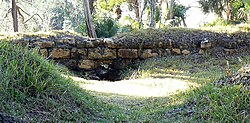San Marcos de Apalache Historic State Park
|
Fort San Marcos De Apalache
|
|

One of the small remaining portions of the stone wall of the Spanish fort, San Marcos de Apalache.
|
|
| Location | 18 mi. S of Tallahassee, St. Marks, Florida |
|---|---|
| Nearest city | St. Marks, Florida |
| Coordinates | 30°09′18″N 84°12′40″W / 30.15500°N 84.21111°W |
| NRHP Reference # | |
| Significant dates | |
| Added to NRHP | November 13, 1966 |
| Designated NHL | November 13, 1966 |
San Marcos de Apalache Historic State Park is a Florida State Park in Wakulla County, Florida organized around the historic site of a Spanish colonial fort (known as Fort St. Marks by the English and Americans), which was used by succeeding nations that controlled the area. The Spanish first built wooden buildings and a stockade in the late 17th and early 18th centuries here, which were destroyed by a hurricane.
The stone fort was built beginning in 1753. It came under successive control by Great Britain, Spain, the United States and, lastly, the Confederacy during the American Civil War. The Confederate Army built a Marine hospital from the materials of the fort. The US took control of the site again in 1865, and the fort site was abandoned.
On November 13, 1966, the fort area was designated a National Historic Landmark because of its significance and added to the U.S. National Register of Historic Places. Designated as a National Engineering Landmark, the fort site has been highlighted on the Florida Native American Heritage Trail.
The historic park is located in the vicinity of St. Marks, off S.R. 363, at 148 Old Fort Road.
In 1679, the Spanish built a wooden stockade at this site which they called San Marcos de Apalache. It was part of their colonial expansion in the northwestern Florida area. A settlement developed around the fort beginning about 1733. Another wooden structure was built about 1753. The wooden fort was destroyed and the garrison drowned, during a hurricane.
In 1759, the Spanish began to build a stone fort, designed to resist bombardment by ships. They abandoned it to Indians for use as a trading post after ceding this territory to the British following the defeat of France in the Seven Years' War, aka the French and Indian War. The British had a garrison at the fort.
...
Wikipedia


